![]() By Jesse Simms | Data-Driven Marketing | Published October 15, 2024 | 7 Minute Read
By Jesse Simms | Data-Driven Marketing | Published October 15, 2024 | 7 Minute Read
Data models help businesses transform vast amounts of raw data into actionable insights that directly impact revenue. Whether you’re using direct mail, email marketing, social media, or a mix of channels, data modeling allows you to fine-tune your marketing to be more precise and effective.
In this post, we’ll dive deep into how data models can fuel business growth, improve marketing ROI, and increase purchases—giving you a powerful edge over the competition.
What Is Data Modeling?
At its core, data modeling is the process of creating a visual or conceptual representation of your customer data.
This allows you to:
-
- Identify patterns and similarities within your audience
- Pinpoint the most important factors driving customer behavior
- Use these insights to create highly targeted marketing campaigns
Data modeling helps you understand not just who your customers are, but what motivates them to take action. Armed with this knowledge, you can design marketing strategies that resonate deeply with your audience and drive higher conversion rates.
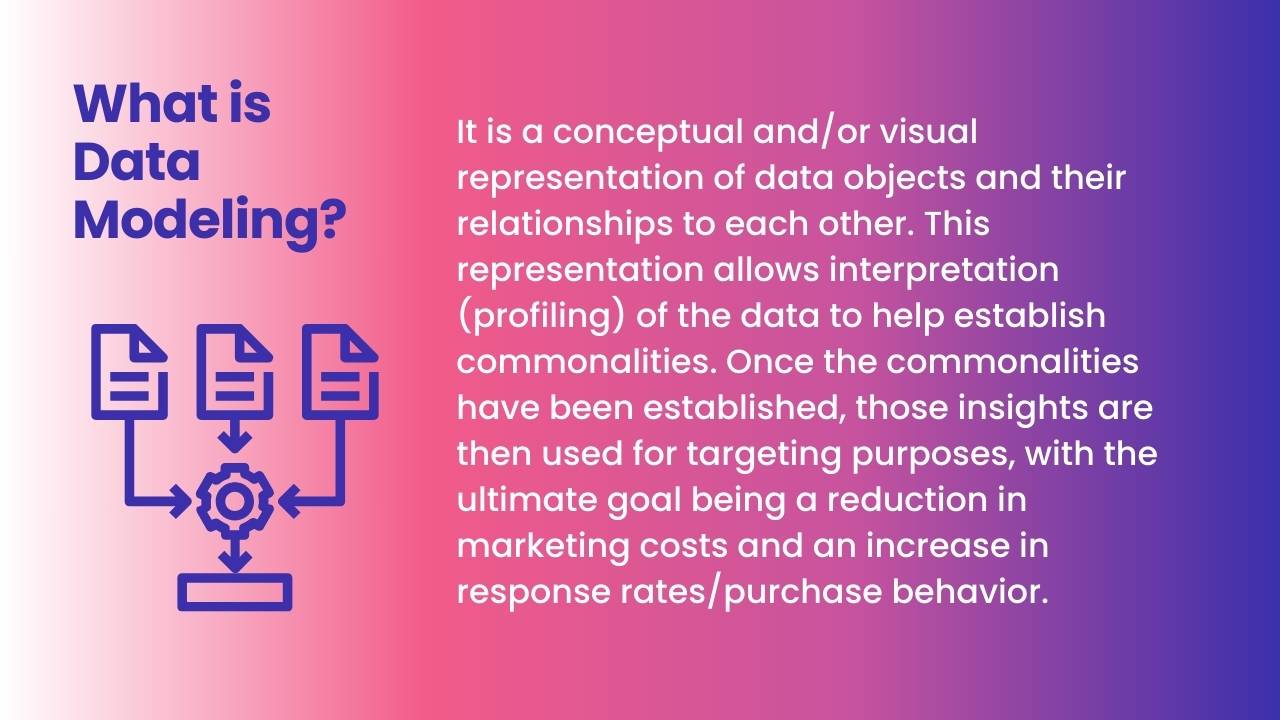
Key Elements of a Strong Data Model:
- Demographic Information: Age, gender, education, income level, etc.
- Behavioral Data: Purchase history, online browsing behavior, frequency of engagement.
- Psychographic Insights: Interests, values, lifestyle preferences.
- Transactional Data: Purchase frequency, average order value, loyalty to your brand.
By combining these elements, businesses can create detailed profiles of their customers, uncovering insights that lead to more strategic marketing.
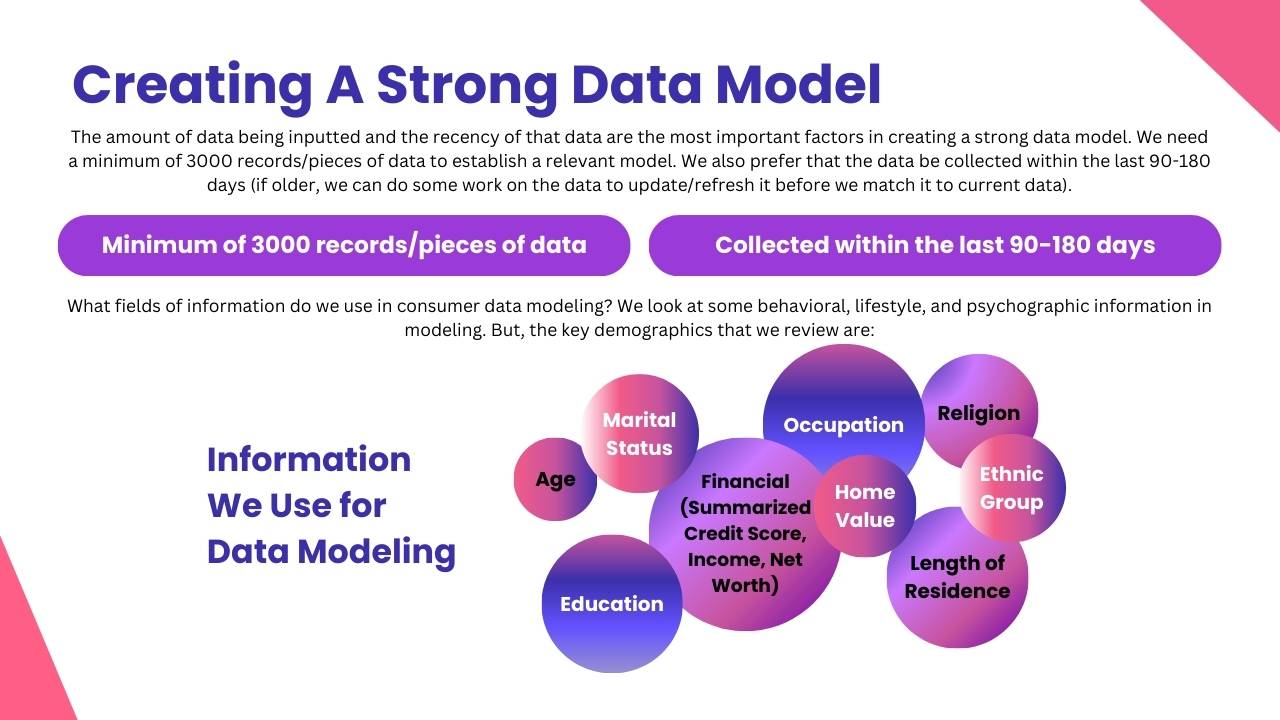
5 Reasons Why Data Models Matter to Business Growth
Data models are no longer a luxury for large corporations. They are essential for businesses of all sizes looking to maximize the return on their marketing investments. Here’s why businesses across industries are relying on data models:
1. Precision Targeting
Data modeling allows you to understand your audience at a granular level, ensuring your marketing efforts are focused on people who are most likely to buy. Instead of targeting large, broad groups, you can focus your efforts on highly specific customer segments.
For example, when the largest furniture retailers in the US came to us, they wanted to improve their marketing efforts across direct mail and digital channels. Through data modeling, we identified that homeowners who had lived in their homes for less than 2 years or more than 15 years were the most likely to make furniture purchases. With this insight, we tailored our campaigns to target this specific group, leading to a 400% increase in response rates.
Why it matters: Precision targeting means that every marketing dollar is spent wisely, focusing on audiences most likely to convert.
2. Better Customer Profiles for Personalization
One of the biggest challenges businesses face today is personalization. Customers expect brands to speak directly to their needs, preferences, and pain points. Data modeling helps you build robust customer profiles that go beyond basic demographics.
By analyzing data from various sources, you can uncover insights like:
- What stage of life a customer is in (new homeowner, retiree, young professional)
- What types of products they’ve purchased before (luxury items, necessities)
- What interests and hobbies they have (sports enthusiasts, tech lovers, outdoor adventurers)
High Performance Kayaking company is a great example of this. Their high-end collapsible kayaks come with a $3,000+ price tag, so they needed to target the right audience carefully. By building customer profiles based on income levels, hobbies, and outdoor interests, we were able to isolate high-income kayakers. This led to a 303% increase in response rates across their marketing channels.
Why it matters: Personalization leads to stronger customer relationships and higher conversion rates, as customers are more likely to engage with content that feels relevant and tailored to their needs.
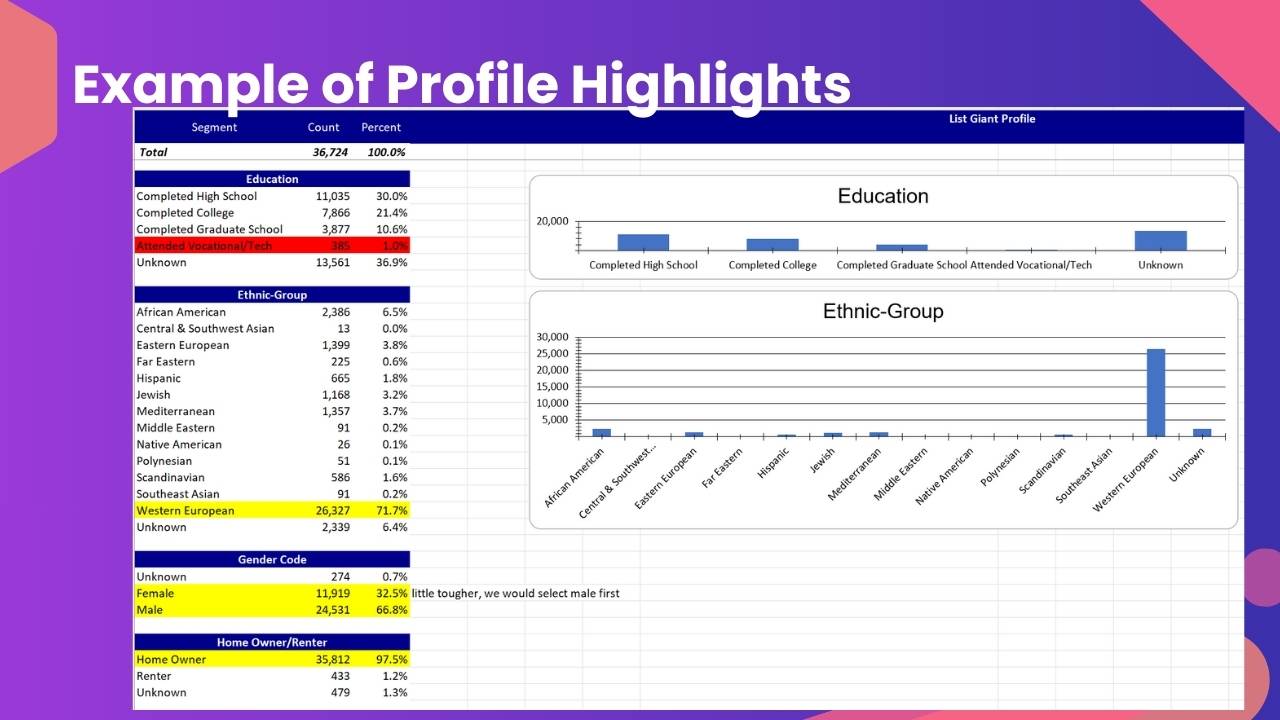
3. Cross-Channel Consistency for Maximum Impact
Customers today interact with brands across multiple platforms—social media, email, websites, and more. With data models, you can create a consistent experience for customers across every channel, reinforcing your message at each touchpoint.
When working with The largest luxury automaker in North America, we didn’t just rely on one channel. Instead, we used data models to identify high-net-worth individuals who were in the market for luxury vehicles. We then targeted them with omni-channel campaigns, including email, social media, and direct mail, ensuring that they encountered consistent messaging across all platforms. This holistic approach helped boost dealership traffic and sales.
How cross-channel data modeling works:
- Email campaigns: Personalized offers sent to customer inboxes.
- Social media: Targeted ads on Facebook, Instagram, and LinkedIn.
- Direct mail: High-impact, personalized mailers delivered to homes.
Why it matters: Consistent messaging across all channels creates a unified brand experience, leading to stronger engagement and more conversions.
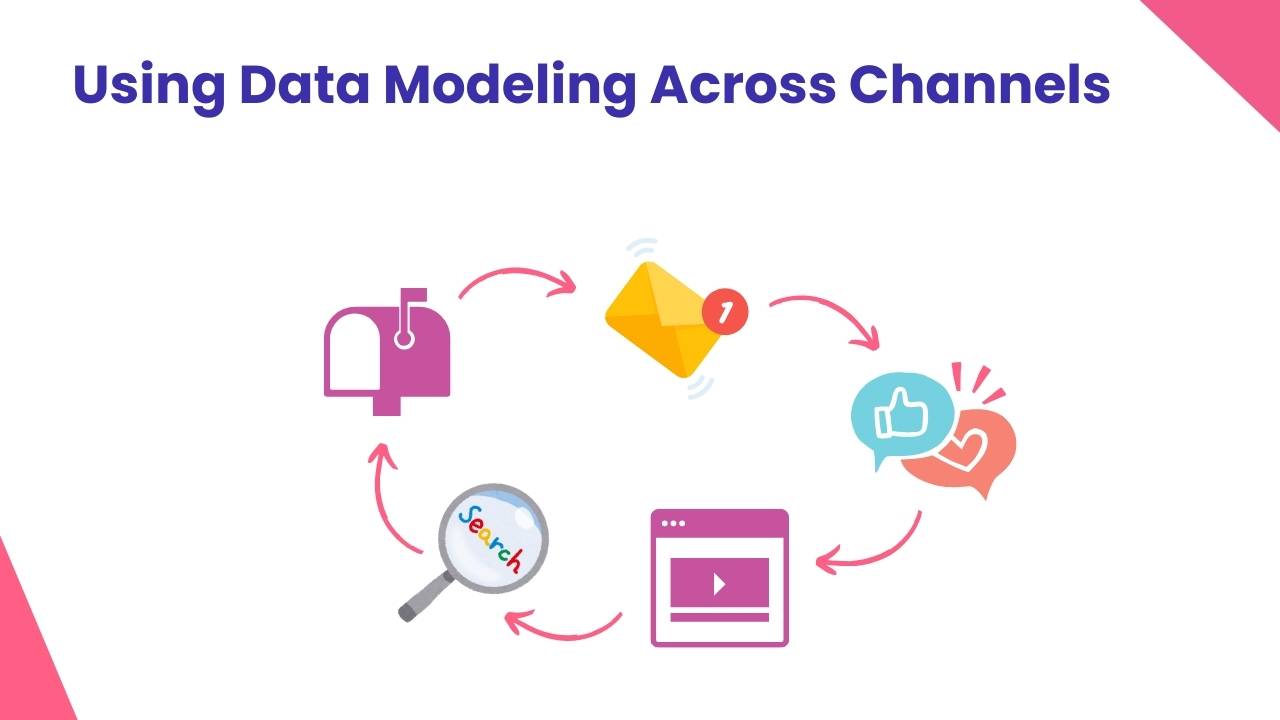
4. Reduce Marketing Waste and Boost ROI
Marketing waste—spending money on broad, untargeted campaigns—can drain your budget. Data modeling helps reduce waste by ensuring your marketing dollars are spent on high-probability buyers.
For example, The high end kayak brand didn’t waste their marketing budget by targeting the general public. Instead, we used data models to isolate outdoor enthusiasts with high disposable income. This led to more targeted marketing and a significant reduction in wasted spend.
Data Models Help You:
- Identify high-value customer segments
- Suppress low-value or irrelevant audiences
- Focus your budget on high-impact channels
Why it matters: Data models optimize your marketing spend by focusing resources where they’ll deliver the highest ROI.
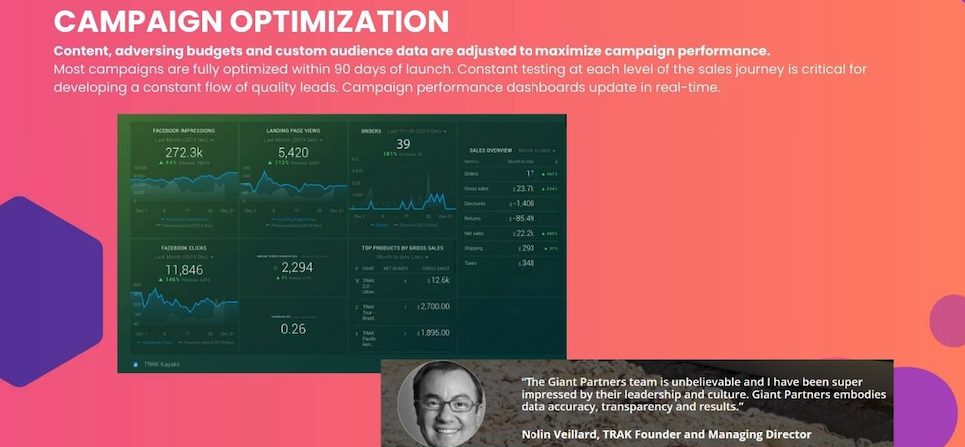
5. Drive Continuous Growth with Evolving Data
The beauty of data modeling is that it’s not a one-time effort. As your business grows, so does your data. By continually refining your data models, you can uncover new trends, spot emerging opportunities, and optimize your marketing strategies.
Here’s an example: After working with the Largest Furniture Stores in the US for several years, we continued updating and analyzing their data. As a result, we identified new geographic areas where potential buyers were emerging. This helped the company expand into new markets and drive further growth.
Key Benefits of Ongoing Data Modeling:
- Evolve with customer trends: Stay ahead of shifting preferences and behaviors.
- Discover new markets: Spot opportunities in underserved or emerging demographics.
- Improve campaign performance: Refine your targeting for even better results over time.
Why it matters: Businesses that continuously update their data models stay agile and can adapt quickly to changes in the market, leading to sustained growth.
Real-Life Data-Driven Success Stories: How Data Models Drove Results
Let’s take a look at how real businesses are using data models to achieve outstanding results:
Largest US Furniture Stores
- Challenge: Reach homeowners most likely to buy furniture.
- Solution: Use data modeling to target homeowners based on their length of residence.
- Result: 400% increase in response rates, with tens of thousands of new qualified leads added to their database every month.
Largest Luxury Automaker in North America
- Challenge: Target high-net-worth individuals looking for luxury cars.
- Solution: Apply data modeling across email, social, and direct mail campaigns to target affluent, competitive vehicle buyers.
- Result: Significant increase in dealership traffic and vehicle sales.
High Performance Kayak Brand
- Challenge: Reach high-income outdoor enthusiasts likely to buy a $3,000+ kayak.
- Solution: Isolate wealthy outdoor adventurers using data models to target them via email, social media, and web ads.
- Result: 303% increase in response rates, with a significant reduction in marketing spend.
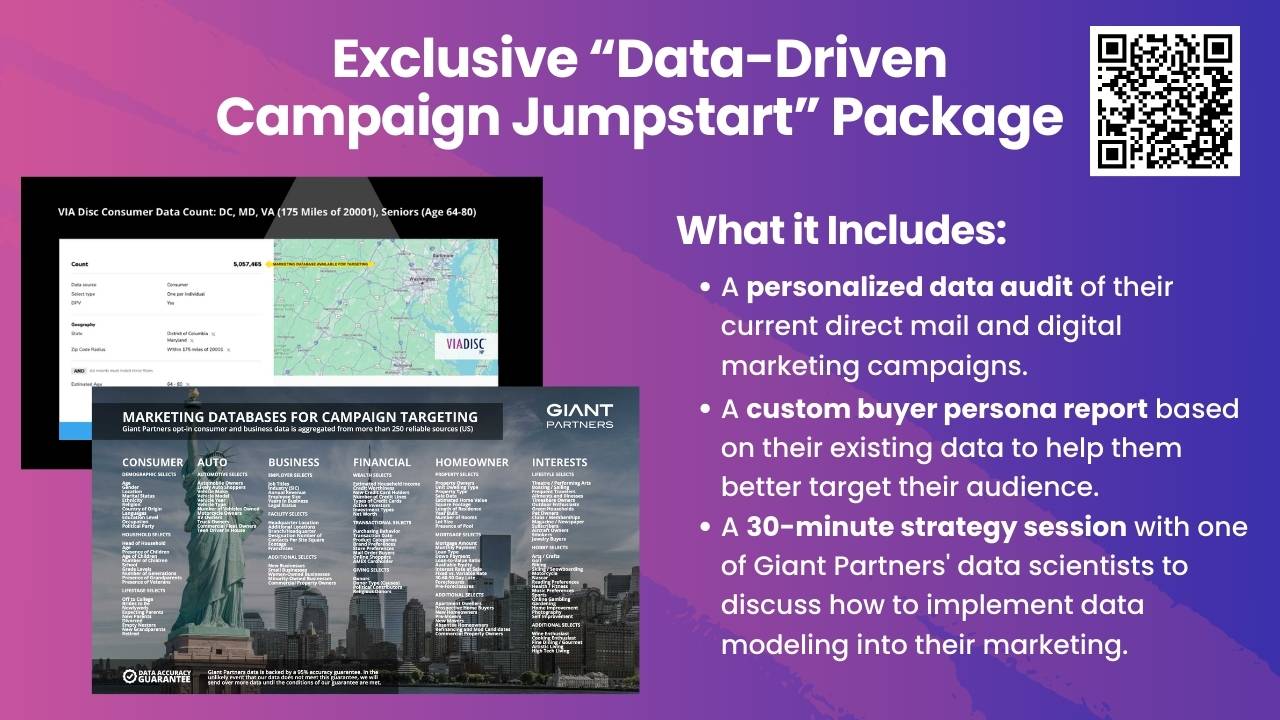
Take Action Today: Use Data Models to Drive Growth
If you’re ready to grow your business by reaching the right customers, it’s time to explore the power of data modeling. Whether you’re targeting luxury buyers, homeowners, or niche audiences, data models can help you get more out of your marketing efforts.
At Giant Partners, we specialize in creating custom data models that drive measurable results. Let us help you unlock the potential of your data and start seeing real growth.
Get Your Free Data-Driven Campaign Jumpstart
Want to see how data models can transform your marketing? Book a free 30-minute strategy session with one of our data experts today. Here’s what you’ll get:
- A personalized data audit of your current campaigns
- A custom buyer persona report based on your data
- Actionable advice on how to integrate data modeling into your marketing strategy
About Giant Partners
24 years. 6000 customers. Giant Partners is America’s #1 data driven marketing agency. We accelerate campaign performance with custom audience data, brand management, website development, CRM integration, email marketing, and omni-channel advertising.














